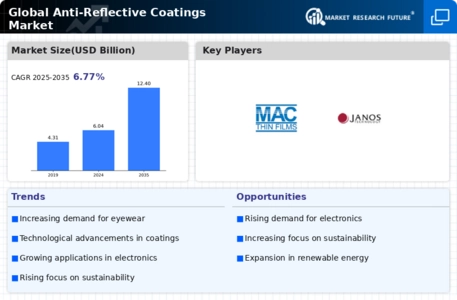Top Industry Leaders in the Anti Reflective Coatings Market
 In a world obsessed with visual clarity, anti-reflective coatings (ARCs) are the stealthy heroes, cloaking surfaces in an invisible shield that vanquishes unwanted reflections. From phone screens that shimmer under the sun to eyeglasses that banish glare, ARCs permeate diverse industries, and their market reflects this ubiquity. Let's peel back the layers of this intricate landscape, exploring the key players, their winning strategies, and the factors that determine who gets to shine the brightest.
In a world obsessed with visual clarity, anti-reflective coatings (ARCs) are the stealthy heroes, cloaking surfaces in an invisible shield that vanquishes unwanted reflections. From phone screens that shimmer under the sun to eyeglasses that banish glare, ARCs permeate diverse industries, and their market reflects this ubiquity. Let's peel back the layers of this intricate landscape, exploring the key players, their winning strategies, and the factors that determine who gets to shine the brightest.
Key Players and Winning Strategies:
Global Coating Titans: Companies like Schott AG (Germany), Corning Incorporated (US), AGC Inc. (Japan), Saint-Gobain (France), and Hoya Corporation (Japan) hold significant market share, leveraging their vast production capacities, diverse coating technologies, and established global footprints. Schott, for instance, dominates the high-performance optical lens segment with its advanced ARCs.
Regional Champions: Players like Young Optics Technology Co., Ltd. (China) and Pilkington Group Ltd. (UK) excel in specific regions, capitalizing on local manufacturing expertise and understanding regional market needs. Pilkington caters to the European architectural glass segment with its cost-effective ARC solutions.
Sustainability Champions: Emerging players like Evonik Industries AG (Germany) and PPG Industries, Inc. (US) are carving a niche through eco-friendly offerings. Evonik focuses on developing bio-based and readily-recyclable ARC materials, aligning with the growing demand for sustainable solutions.
Niche Specialists: Smaller players like Gentec Optical Systems, Inc. (Canada) and Nano-C (US) push boundaries with cutting-edge advancements. Gentec specializes in customized ARCs for medical imaging equipment, while Nano-C focuses on developing self-cleaning and superhydrophobic ARCs.
Factors Shaping Market Share:
-
Performance and Functionality: Offering ARCs with superior light transmission, minimal reflection, durability, and additional functionalities like scratch resistance or self-cleaning is crucial. Schott's high-performance optical ARCs exemplify this focus.
-
Sustainability and Environmental Footprint: Reducing solvent emissions, utilizing renewable feedstocks, and minimizing waste generation are becoming essential criteria for market penetration, driven by stricter regulations and eco-conscious consumers. Evonik's bio-based ARCs resonate with this trend.
-
Cost-Effectiveness and Value Proposition: Balancing high performance with competitive pricing is vital, particularly in price-sensitive segments like consumer electronics. Pilkington's cost-effective ARCs for architectural glass find favor in budget-conscious projects.
-
Technological Advancements and Applications: Constant research and development of new ARC technologies with additional functionalities, like improved light management or anti-counterfeiting properties, opens up new avenues for market growth. Gentec's specialized ARCs for medical imaging illustrate this trend.
Key Companies in the Anti-Reflective Coatings market include
- RODENSTOCK GMBH (Germany)
- Janos Tech (US)
- ICOAT COMPANY LLC (US)
- Honeywell International Inc. (US)
- MAC Thin Films (US)
- PPG Industries Inc. (US)
- YTC America Inc. (US)
- Royal DSM N.V. (The Netherlands)
- HOYA VISION CARE COMPANY
- Carl Zeiss AG (Germany)
Recent Developments
-
September 2023: Evonik secures funding to expand its production capacity for bio-based ARC materials, anticipating increased demand from eco-conscious manufacturers. -
October 2023: Nano-C introduces a novel superhydrophobic ARC for textiles, offering unparalleled stain resistance and self-cleaning properties.
-
November 2023: Schott collaborates with a university research group to develop self-healing ARCs for aircraft windshields, aiming to reduce maintenance costs and extend lifespan.
-
December 2023: The American Coatings Association releases a white paper on best practices for responsible sourcing and ethical extraction of raw materials for ARCs, promoting transparency and sustainability throughout the supply chain.

